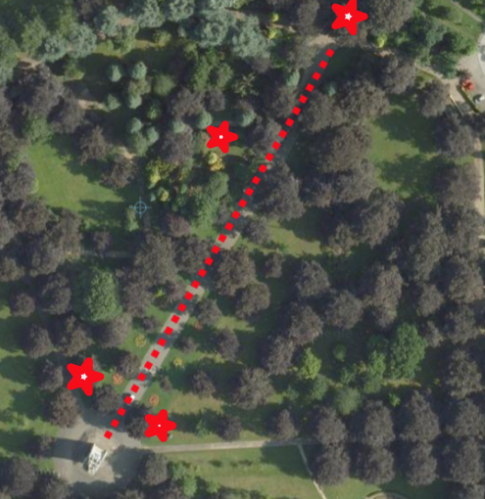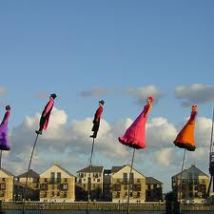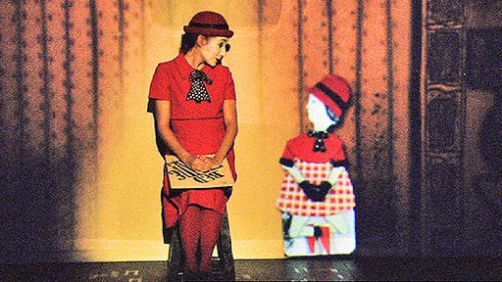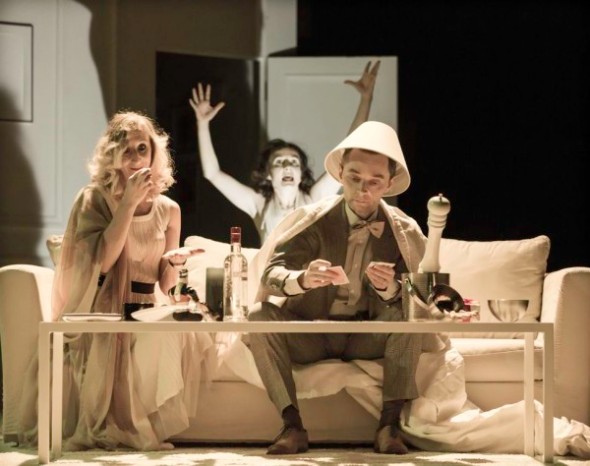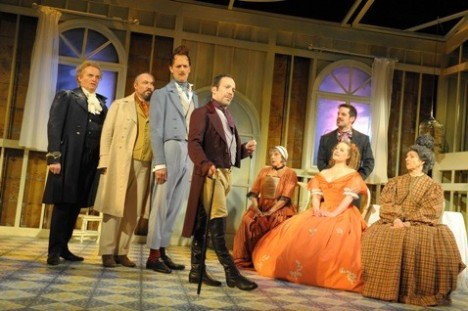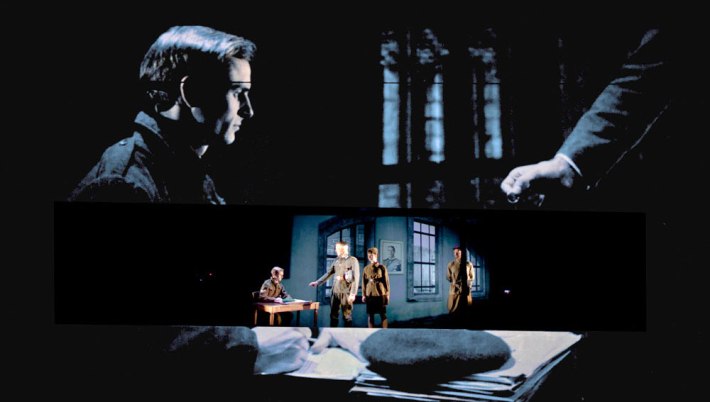As part of our New Landscapes module, the year was split into groups with a different story to tell. Ours was “Sinbad and his Seven Voyages”. The other groups were given more straight forward stories with a beginning, middle and end, such as “Aladdin”. In our attempt to make “Sinbad” more of a flowing story, we looked at all seven of the journeys and managed to splice them together to make one epic adventure. Personally, I found this easier to work with, especially as we had managed to cut so much out of the voyages that wouldn’t have been missed by an audience. Sadly, after our first rough performance, it appeared that we had cut too much and the audience had expected to see different voyages, rather than one big one. They also thought that even though the piece was named after our main character, we didn’t make the most of him and needed to define him more.
In our next rehearsal we began looking at the original story, plus the smaller version we had created and decided which of the voyages would be most interesting for an audience to watch, as well as which ones would be most effective in an outdoor space. In the end, we decided to portray all seven but using different theatrical techniques to create them so that the audience wouldn’t get bored.
Voyage One: This was the introduction to the piece and because of that, we used this time to introduce Sinbad as the main character and establish him more than we did in our original performance. We also included songs, written by James, Alex and Emma C as we knew that this would be a large part of the Arabian Nights performance at the end of the module. This voyage consisted of the whale story in which Sinbad lands on an island that is in fact the back of a giant whale. Originally we wanted to make this part very acrobatic based, as Sinbad is flung in the air via the whale’s blowhole, and in our shortened version of the story we had him summersault over someones back to give him the height he needed. In the rest of this story, the crew tie themselves on to the leg of a bird and then land on a different island, leading in to voyage two much like we did in our rough performance.
Voyage Two: This was the Cyclops story, but for convenience purposes, the Giant story as we didn’t have the appropriate one-eyed mask. In this story, Sinbad and the crew enter a creepy castle that is inhabited by a carnivorous giant that captures the crew and eats the captain.

I played the Giant and was quite happy to as it allowed me to take my new stilts out for a test drive!
This was the first performance I’d used them for since the Fabularium project in 2012 and because of this I spent a lot of time practising on them in different weather conditions
 and landscapes as at this point we hadn’t chosen a location to set the piece. I found walking around in the woods very useful as the ground was so unsteady and I had to practise keeping my balance a lot more than I would have when I was on a flat surface.
and landscapes as at this point we hadn’t chosen a location to set the piece. I found walking around in the woods very useful as the ground was so unsteady and I had to practise keeping my balance a lot more than I would have when I was on a flat surface.
The location for this scene was between two trees that were slightly raised so the ground sloped more than usual. This, mixed with nerves, made me a little wobbly and I wasn’t as steady as I could have been.
Voyage Three: This was the cannibal story in which Sinbad’s crew are eaten alive after being drugged. This was one of the stronger stories, I found as we all seemed to have fun with it. We made it a bit more cartoon-y than the others so the cannibals were more like the Hyenas from “The Lion King” rather than sinister villains. I spent most of this story behind a tree getting my stilts off and changing in to my next costume so unfortunately can’t comment on what was done.
Voyage Four: Again, I found this to be another one of our stronger performances. Sinbad is offered the hand of a Princess and then accepts without hearing the consequences. For this, I choreographed a little dance routine for the girls to do that was simple yet did the job of establishing them as the Kings beautiful daughters. We also included more acrobatics in this scene to show Sinbad’s escape from his cruel fate.
Voyage Five: This story was mainly a duologue between Sinbad and an Old man but throughout it, the rest of the cast accidentally ended up acting as a present chorus, we all watched the action intently ready for the next voyage.
Voyage Six: This was not an theatrical voyage, instead, I had created a mural on cloth that was inspired by this depiction of the hobbit by ‘breathing2004’

I used the same shape and method of colours fading into each other. Unfortunately it wasn’t as detailed as this but each image was clear and large within the piece. This was accompanied by Alex narrating the adventures as if he were deciphering a ruin. This painting was definitely a different element in not only our piece, but throughout the performances and hopefully the audience enjoyed the change.
Voyage Seven: This was the final journey and consisted mainly of an acrobatic fight scene that was a group effort to choreograph. Because our Sinbad (Radu) was a flyer, it was easy to create effective scenes with him leaping and bounding off different pirates, taking them all out. I am a base and once Sinbad had defeated several of the pirates, we were left to battle two on our own. This was one of my favourite points within the piece as it was energetic and just fun to be involved in.
The location we chose was a grassy square lined with trees that were thick enough to use as “off-stage”. The audience were meant to stay central as each scene was laid out in a circle around them, this didn’t really work as the audience gathered around each scene. We didn’t anticipate that they would move as much as they did. If we were to do it again, I would have prefered to make it a definite promenade performance rather than the audience merely having to turn 360 degrees around one spot.
Because we had to make several different short scenes, our piece was longer than everyone else’s but was still entertaining enough that we got away with it!

 and landscapes as at this point we hadn’t chosen a location to set the piece. I found walking around in the woods very useful as the ground was so unsteady and I had to practise keeping my balance a lot more than I would have when I was on a flat surface.
and landscapes as at this point we hadn’t chosen a location to set the piece. I found walking around in the woods very useful as the ground was so unsteady and I had to practise keeping my balance a lot more than I would have when I was on a flat surface.

